Are you attending a Dickens-themed event? Whether you are participating in a Dickens Fair, are part of a Victorian caroling group, or are part of a Dickens production such as A Christmas Carol, it’s important for a lady to know how to dress the part! We’re here to wrap it all up for you in a big beautiful Victorian bow.
Share Your Dickens Event
We want to know about your Dickens event or group. Post in the comments section below (include a link, if available, so we can all visit!). We’d love to feature your event in an upcoming blog post.
First thing’s first: Victorian underpinnings
So, where to start your character for a Dickens event? Obtaining the proper silhouette for the era begins with underpinnings.
- First stockings or over-the-knee socks –
“made of silk, cotton, or wool they came in vertical stripes, horizontal, stripes, checks, plaid tartan and windowpane in both small and large prints.” Even though they were never seen, these colorful leg coverings created a little excitement for the wearer.
- Pantaloons, pantalets or drawers on the bottom – whatever you call them, they go next to the skin and over the stockings before the petticoats.
- A corset
- A corset cover or chemise.
- Next – the petticoats or crinoline depending on what style of dress and decade you are dressing for.
Do you know why the hoop crinoline was developed? Because women were wearing six or seven petticoats under their dresses to create that bell shape for their skirts. Who wants to be weighed down by that many undergarments? Plus, it had to be hot during summer!
“The hoop skirt gained a foothold in the mid-1850s and eventually replaced the large number of petticoats formerly worn.” (Women’s Costume) The hoop was worm by mid and upper-class women during the Civil War era. Check with your group to see how wide your skirt can be. You want to make an impression but still have room for others.
Want to learn more about crinoline? Check out our blog post: Crimes of Fashion
Onward to the Dress
- During much of the “Dickens-era” the tops of women’s dresses had high necklines, especially for day wear. Pagoda or bell ¾ sleeves were very popular. White undersleeves would often be worn to help protect the top. They are removable for easy cleaning.
- Form-fitting jackets were also a popular style for tops. Tops “were either collar-less or had a small Peter Pan style collar, made of self-fabric or a detachable knitted or crocheted one.” The bolero jacket was also very popular during this time period.
- Lower-class women and sometimes women of greater means wore white cotton front-button blouses. The blouses might be embroidered or lace-trimmed. The blouse alone was too informal for the mid-Victorian woman. Blouses were always covered by a jacket.
There were a lot of different options for neckwear during the Victorian era. Learn more on our blog post Victorian and Edwardian Neckwear.
- When creating a dress, the bodice, or top, and the skirt would be made of the same material. Depending on your group, you may need to seek out era-appropriate fabrics, especially prints. Or, you can select one of our Victorian gowns for your event.
Browse our stunning collection of Victorian dresses and gowns here.
Outerwear and Accessories
- Before you put on your petticoats and gown make sure to get your boots on! Once the petticoats went on, it was very difficult to put on your boots! Boots were very popular during the mid-19th century. Most boots were mid-calf or lower and laced up.
- When going out, ladies had a few choices to keep warm. The shawl was very popular as was the pelerine, a shoulder cape with long lappets hanging down the front. Capes or cloaks and coats took center stage during cold weather.
- A Victorian woman wasn’t dressed to leave the house without a hat. Mob caps were worn indoors to protect hair from dirt. They were easy to launder. Lower-class women would also wear them outdoors. Most women of Dickens wore bonnets when going out. There were many varieties of bonnets. Others wore elaborately-trimmed hats, but the bonnet was the dominant headwear of the period.
Want to make sure you get just the right bonnet for your event? Read up on the different types here: Bonnets Through History: Can You Tell Them Apart?
- A woman’s hands would also be covered when going outdoors. Gloves were made of kid leather or lace. Leather was often colored so it was common to purchase them to complement an outfit. Gloves worn during the day were generally short. When the weather was cold, a muff was used to keep the hands warm.
Make sure you know the proper way to use gloves at your event! Read up on Victorian glove etiquette here.
- A woman during Dickens’ time would have carried a reticule. A reticule is a small purse not much larger than a pocket or clutch, used to carry just a woman’s essentials. There were many different styles, but were typically closed using a drawstring. You can see the variety on our post What’s in Your Reticule?
- Women of the Dickens period wore different jewelry for day and night. Cameos and pearls were very popular. Other popular jewelry included earrings, rings, brooches, and pins. Depending on the event, women would have carried a parasol or fan. Working-class women would have worn an apron.
Let us inspire you! Browse our collection and start getting your dream Dickens outfit put together.
Going to an Edwardian event? Things changed a lot between the Victorian and Edwardian eras. Prep for your event using our guide: Preparing for an Edwardian-themed Event.
More about Victorian fashion:
The Rise and Fall of the Bustle: A Short History
Staying Warm in the Victorian Winter
Victorian Riding Habits: More Than Meets the Eye
A Short History of the Hand Muff, One of History’s Cutest Accessories

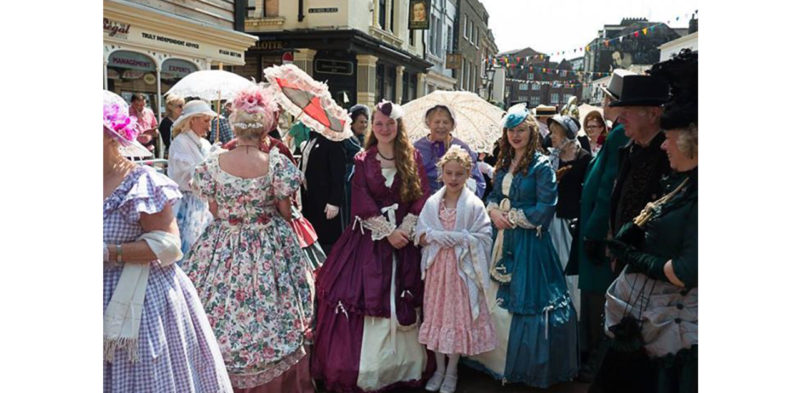
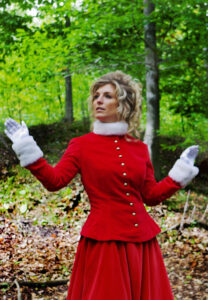
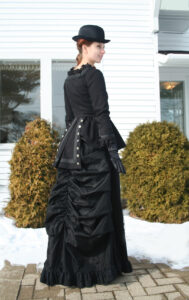
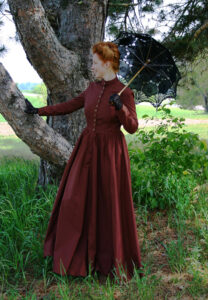
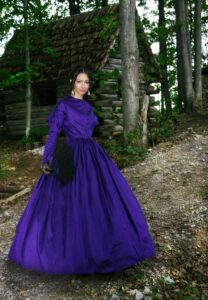












https://www.youtube.com/watch?v=2ClnKyHM8mQ
Dickens on the Strand!
Galveston, TX
The very best…
Dickens Fair, each Feb in Riverside CA—including dance lessons, a ball and a fantastic fashion show.
Fezziwegs ball. Worcester, MA Dec held at armory FANTASTIC!!K